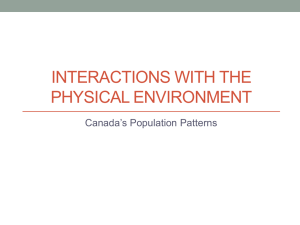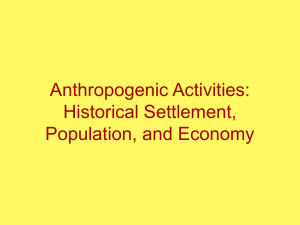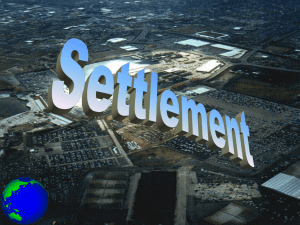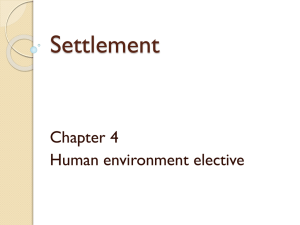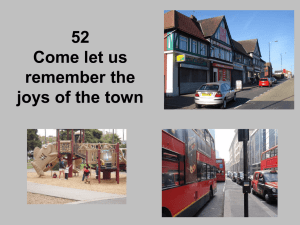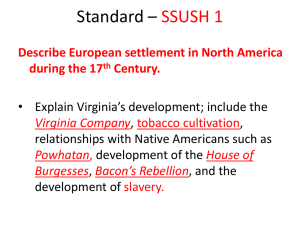Settlement
advertisement
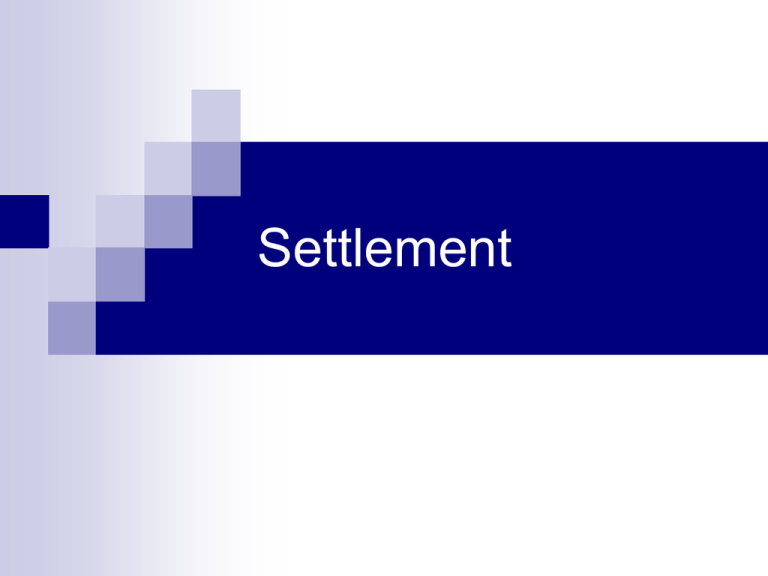
Settlement Definitions Site: the land or area on which a settlement is built Situation: location in relation to the surrounding area Function: intended purpose for the settlement (can change over time) Site: Area’s main physical characteristics Close to water supply Altitude: low lying Aspect: south facing slopes Dry point – good defensive sites Nodal points Resources: minerals Coastal areas Situation: Location of settlement in relation to surrounding area Natural routeways: gaps & valleys Developed routeways: transport lines Function: Towns main economic activities Towns today are multi fiunctional R eligious I ndustrial C ommercial & Communications E ducational P orts O pen Spaces (recreational) T ourism S ervices Physical factors effecting location questions to ask… Relief: is the land flat enough to build on? Drainage: is there a water supply near by and is the land well drained? Soil quality: can the land provide food? Altitude: is the site on low land? Aspect: is the site in a sunny sheltered location Advantages offered by river sites 1. 2. 3. 4. 5. Water and food supply A fertile floodplain Flat land which is easy to build on and travel across Transport: either on the river or across it Defence: river bends and islands are easily defended The site of Irish Settlements Sheltered harbour- Dungarvan, Co. Waterford Bridging point- Ballina, Co, Mayo Route focus: Mullingar, Co. Westmeath Dry point: Clonmacnoise, Co. Offaly Centre of fertile farmland, Athy, Co. Kildare Distribution and density of settlements on OS Maps Describing distribution 1. Describe where people are located 2. Link this to factors 3. refer to areas where people are absent and why they are absent 1. 2. 3. Describing density Note areas with significant amount of housing Link to factors favouring settlement Note areas of dispersed or clustered settlement etc by using map evidence Development of settlement on maps and photographs You are expected to identify and locate by 6-figure grid reference and then describe and explain various periods of past and modern settlements All ancient settlements are labelled as antiquities on the OS map Historic Settlements: What to look for on OS maps Mesolithic (7000 BC) middens Neolithic (new stone age) (3500 BC) First Farmers, low lying land near rivers, soil was fertile, river provided food, water and transport. Map evidence: Megalithic tombs, barrows, portal dolmen, passage graves, court cairns, stone circles, standing stones Bronze age (2000 BC) Copper mines, barrows, cist graves, wedge tombs Iron age/ Celts (600 BC- 500) From Central Europe, Iron weapons, Defensive structures: elevated sites, cliff edges, centre of lakes, scattered across country Map Evidence:Ring forts, promontory fort, hill forts, crannog, barrows, fulacht fia Early Christian (500-800 AD) St Patrick, Illiterate, stone crosses, monastic life, round towers for protection, monasteries became first towns, education and alms Map evidence: Holy well, cross inscribed stones, round towers, high crosses, cillin, monasteries, churches Historic Settlements: What to look for OS Maps Viking (800- 1000 AD) Longboats, plundered monasteries, towns developed on dry sites, trading centres, sheltered mouths of rivers Map evidence: Found in place names ending in ‘ford’ and ‘low’ or port towns on the east or south of Ireland can be an indicator Norman/ medieval (1100- Bend of river, elevated site, defensive 1500 AD) & trading purposes, bridging point, towns walls and gates to control trade and disease, encouraged religious orders Map evidence: Stone castles (near rivers & bridging points), motte and bailey, priories and abbeys Plantation (1500-1700) English planters, Fortified buildings, defensive walls, Main street with market square, weekly fairs, well planned, near large estate/demense Map evidence: Fortified houses, demesnes, place names with grange or lott, or town named after people (Charleville) Georgian (1700-1800) Most easily seen on photographs, grid pattern or street plan, square markets in towns Industrial/resort/dormito Urban planning, counteracted urban ry/ new towns (1900sprawl, 2000) Map evidence: areas route focus, modern services, industrial estates The historic development of Dublin: case study Dublin city has developed over many centuries. Traced through evidence. Viking Dublin (800-1000) Easily defended site of the black pool (Dubh Linn) Dry point of the river Liffey Nearby settlement of Ath Cliath (west) provided wealth, goods for plunder and a market Native population captured sold into slavery Dublin very important port in the Viking world (outside Scandinavia) Excavations at Wood Quay showed main features ie. Religious buildings, areas for markets, craftwork, food storage, fortified areas The historic development of Dublin: case study Norman Dublin (1100-1500) Norman invasion major effect on the Irish landscape Characteristics of a Norman town incl. moat, castle, town walls and gates, market place, church/monastery/priory Important buildings made of stone (Norman walls and gates still intact on Cook Street) Castle was built close to the Viking high street, walls surrounded the whole of Dubh Linn Dublin castle stood in the strategic location beside Dublin bay. Native Irish were not allowed to stay within the walls after dark. An irish only settllement developed outside the town, eg. Irishtown in Ringsend. The historic development of Dublin: case study Georgian Dublin (1700-1800) Time of growth and construction. Stone structures replaced wooden structures Wealth reflected in buildings such as Custom house, Four Court and the GPO Home to members of the Irish parliament (wealthy Protestant land owners) lived in 3/4 stories town houses overlooking private squares which acted as rural retreats in the city. 1801 Act of Union past meaning ireland couldn’t govern itself. Many landlords left the city taking the wealth with them Townhouses became rundown and began to house poorer people leading to the development of tenements and slums. The historic development of Dublin: case study Twentieth century Dublin Poverty and devastation through the 1916 rising, civil war and world wars Post war years planned large housing estates on the outskirts of city ie. Crumlin Many inner city families rehoused in new estates 1960s three new towns built around the villages of Tallaght, Lucan/Clondalkin and Blanchardstown High rise flats build in Ballymun 1980s large out migration industry and housing left vacant and derelict The historic development of Dublin: case study 1990s urban renewal and the Celtic Tiger dublin emerged as an attractive place to live and work. Derlict buildings and vacant lands were redeveloped and renewed into apartment buildings etc The IFSC, Docklands, Temple Bar 2000+ recession paused the construction of projects Unfinished ghost buildings are visible on the dockland Rural settlement patterns Rural areas, individual houses make up settlement pattern Dispersed settlement pattern Clustered settlement pattern Linear/ribbon settlement pattern Absence settlement pattern Dispersed Settlement Pattern Scattered over a wide area Individual farmhouses surrounded by farmland, separated from each other Today the pattern can be seen when houses are located at the end of long roads Dispersed Settlement Patterns Long tradition in Ireland Before the 18th century open field system of farming was practised (common land) Usually surround central settlement After 18th century the system changed land was enclosed by fences and hedges Farm houses were built on there own land that was worked to the benefit of the farmer Dispersed pattern developed by isolated farmhouses surrounded by fields Clustered settlement patterns Houses grouped together Can be found around source of water or a church Road junctions can also be points of clustered settlement Clustered settlement patterns Upland areas in the West of Ireland sign of the old farming system Clachans: small cluster of houses usually owned by extended family Small villages built during landlord times for estate workers Nucleated generally applied to urban settlement Linear/Ribbon Settlement Patterns Arranged in a line usually along a road or a scenic coastal view Linear/Ribbon Settlement Patterns Many people prefer to live in rural areas close to towns to access services Roads entering towns have services ie. Sewerage, water facilities, telephone and electricity cables Less expensive for local authorities to provide them along main roads than each individual laneway Roadsides are valuable places in which to live Farmers often sell the more valuable road frontage sites for housing Leads to unsightly linear pattern or ‘bungalow blitz’ Absence of settlement Area of land may have no settlement due to both physical and human factors Physical: relief, altitude, aspect, exposure to the wind, poor soil or lack of water supply Human: out migration, abandonment of farms Absence of settlement Avoid living in land 200m above sea level (wetter/colder), Soils are thinner and land is steeper Low lying areas may be absent: river floodplains (if there is settlement usually on a dry point) Social: out migration and exhaustion of resources Reasons for the growth of rural housing Housing development in rural areas built to accomadate people working in nearby towns (commuters) Linear development resulting in pressure on services Holiday homes develop along senic coastal areas Rural Planning One off housing Explosion of linear housing – exit routes Celtic Tiger era (1997-2007) 2nd homes, B&B’s Declined – tax levies Issues in planning housing development 1. 2. 3. 4. 5. 6. 7. Provision of services- water, electricity, broadband Provision of employment opportunities in rural for less community Loss of scenic amenity value created by one-off housing Problems of water quality due to seepage from greater number of septic tanks Rising land prices in rural areas. Locals cannot afford land prices Planning permission controls in scenic areas Traffic management issues due to increased commuters Problems associated Ghost estates due to recession people moving futher outside the city many estates left unfinished 621 ghost estates in Ireland Nearly every county has one Worst effected area in Leitrim Measures to support rural population growth 1. 2. 3. 4. 5. 6. 7. 8. 9. The National Development Plan 2007-2013 Providing transport infrastructure to link rural areas to urban centres (Transport 21) Broadband provision throughout country Supporting rural resource based industries such as agriculture and food Village renewal to make villages attractive to live Increase tourist potential Provision of good quality waster supply to rural areas Provision of education and training schemes for rural population Social inclusion, especially older population Preservation of scenic areas Measures to support rural population growth County Development Plan Each county has its own development plan Rural Development plan: Protect the distinctiveness of the rural areas Prevent suburbanisation Strict planning laws Wicklow: planning permission for individual housing in rural areas is only granted to people born and raised in the county or those that have been living or working there for over a year Westmeath: planning in rural areas is only granted to residents or natives . Those who get permission must occupy the house for more than a year Concerned about: Rural service provision, traffic management, pollution, scenic quality, expanding commuter services Functions of Urban settlements Function Example on map/ photo Example Religious Churches, cathedrals Knock Recreational Parks, golf course, marinas Tramore Residential Housing estates Malahide Industrial Industrial estates, factory Navan Communications Post office, transport network Waterford Commercial Shop fronts, shopping centres Galway Functions of Urban settlements Education Schools, Universities, ITs Cork Ports Ships, containers, marinas Killybegs Transport Roads, Rail, Luas, carparks Dublin Open spaces Playing fields, parks, mountains Glendalough Tourism Information offices, picnic sites, golf courses Killarney services Hospitals, garda stations Drogheda Defence (Historic) Walls, mottes, castles Limerick Functions changing over time Settlements have changed over time In answering this question look at the following Town Original function (s) Present function (s) Future function (s) Changing functions in Galway city Located relatively flat site on the banks of river Corrib Large hinterland, major urban centre in the West and fourth largest in Ireland Medieval: Norman landlord built a castle on the land seized from Irish clans (Defensive Function), quickly developed a port function with trade links growing with France (Merchant City) City walls have survived Lynch’s Castle in the city centre (used as a bank since 1927 Changing functions in Galway city Port function: important port for centuries Distribution centre for its hinterland acquiring a transport function Bridges built made it an important crossing point Port function has declined since the importance of the ports in the south and east has expanded Changing functions in Galway city Educational function: 1845 became a university city Location of the university enhanced the importance of the city Recent years: Galway Mayo Institute of technology- the Regional Hospital is a teaching hospital Many schools both primary and secondary Changing functions in Galway city Manufacturing function: Major centre west of the Shannon Location of multinational companies in healthcare and IT High quality of 3rd level graduates and Industrial development authority Led to residential estates cropping up Changing functions in Galway city Other services: Fourth largest city in the Republic Financial, commercial, retail and tourist services Link with the Irish language Functions changing over time Central Place Theory Devised by Walter Christaller in the 1930s Towns located on a plain were spaced a certain distance apart so they would not compete for the same costumer, not by sheer chance Studied towns in Bavaria, Germany Theory maintains that if there is even distribution, equal money, transport opportunities, if the land is flat and featureless then settlements are distributed according to size What's wrong with circles? What’s wrong with circles Source: http://www.uwec.edu/bfoust/155/G155_RS3/sld002.htm Central place theory Central Place Theory A Central Place is a settlement which provides one or more services for the population living around it. Simple basic services (e.g. grocery stores) are said to be of low order while specialized services (e.g. universities) are said to be of high order. Having a high order service implies there are low order services around it, but not vice versa. Central Place Theory Settlements which provide low order services are said to be low order settlements. Settlements that provide high order services are said to be high order settlements. The sphere of influence is the area of under influence of the Central Place. Hierarchy of settlements Hamlets Day to day services Local shops/ bread and milk Fanore Village Low order School/church/petrol station Ballyvaughan Small town Some high order Pharmacy/supermarkets Balbriggan Large town More high order Retail parks/variety of shops Bray/ Ennis Small city Increasing number Hospital/third level college/specialist stores Waterford Large city More high order Cathedral/university/ specialist hospital Killkenny/ Galway Regional centre All services available Administrative and financial insitutions Dublin/Cork Central place theory four basic ideas 1. 2. 3. 4. Threshold population: each service has minimum population to keep it in business Range: maximum distance people will travel for a product or service, range determines the size of the hinterland Frequency of demand: how often a product and service is needed. High frequency demand everyday products Rank order: expensive items brought infrequently are high order ie. Cars, medium order: clothes, low order: milk Central Place Theory Central place is a town or urban centre that provides goods and services Centrality: degree to which serves the surrounding area, measured in terms of goods and services offered New York would have a high centrality Ballygarvin, Co. Cork would have a low centrality Central Place Theory 1. 2. 3. 4. 5. To simplify Christaller made the following assumptions: All movements take place on a flat plain where there is equal distribution Transport is equally easy in all directions so cost is a proportional to distance Customers use rational behaviour, travel to the nearest centre All customers have equal purchasing power and demand constant A hexagon-shaped hinterland gives the best coverage of the area Distribution using Central Place 1. 2. 3. 4. Based on the assumptions central place shows that: The larger the settlement the fewer there are Larger settlements are spaced further apart from each other Large towns have a wider range Larger settlements offer more high order services Distribution using Central Place 1. 2. Exceptions are: Tourist resorts that have a small population but have large number of functions Dormitory towns that have a large population but a small number of functions Criticisms of Central Place Theory 1. 2. 3. 4. CPT is too simplistic and random in allocating ranges and thresholds. Historic view of urban settlement that does not take transport improvements into account Increasing concentration of all services in larger centres People do not always use rational behaviour and tend to shop around for high order goods Christaller’s CPT Christaller made a number of assumptions such as: All areas have・ an isotropic (all flat) surface・ an evenly distributed population・ evenly distributed resources - similar purchasing power of all consumers Limitations of Christaller's model Few real-life regions fit Christaller's model (except the flat lands of the Dutch Polders and East Anglia in the UK) The problem lies in the basic assumptions of the model: People do not always go to the nearest central place (they may chose a new edge of city superstore further away) So the K3 theory wouldn’t work. Large areas of flat land rarely exist. Mountains & hills etc distort transport routes (so the K4 theory wouldn’t work) People and wealth are not evenly distributed (if poorer people live in a certain area & their nearest high order settlement is expensive then they won’t visit it) Governments often control where new towns are located, not market forces (i.e. not necessarily where the demand for goods and Hill services is highest) Train-line Historic Settlement Examine the 1:50,000 Ordnance Survey map of Carrick-on-Suir that accompanies this paper. Using evidence from the map describe and explain three different examples of historic settlement. Central Place Examine the Ordnance Survey map and aerial photograph accompanying this paper. Using evidence from the Ordnance Survey map and aerial photograph, show that Carrick-on-Suir performs the function of a Central Place or market centre for the surrounding hinterland. SETTLEMENT PATTERNS Examine the Ordnance Survey extract that accompanies this paper. Using map evidence to support your answer, identify and explain three patterns of rural settlement. DYNAMICS OF SETTLEMENT With reference to one Irish urban centre that you have studied, examine how its functions change over time. URBAN FUNCTIONS Study the aerial photograph of part of Galway that accompanies this paper. Examine any three functions of the city, using evidence from the photograph to support your answer. POPULATION DENSITY AND DISTRIBUTION Describe and explain, using examples which you have studied, the difference between the terms Population density and population distribution. Central Place Theory Examine this diagram, which refers to Christaller’s Central Place Theory. Explain what you understand by this Theory.
